Healthy Soil
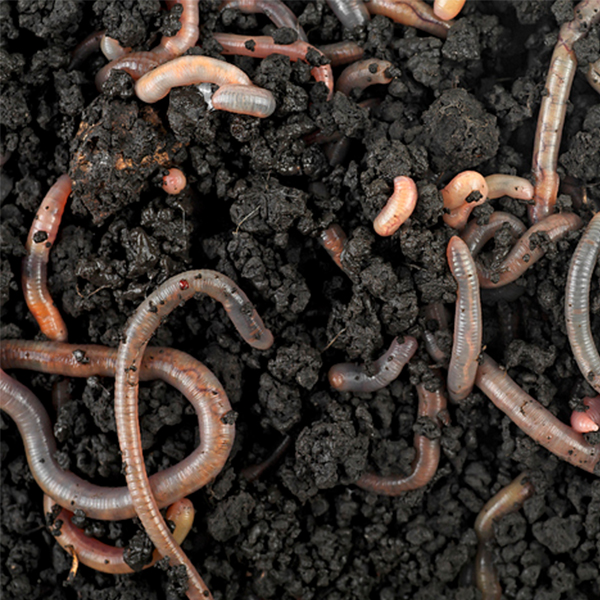
Worms and soil (domnicky, iStockphoto)

Worms and soil (domnicky, iStockphoto)
How does this align with my curriculum?
| Grade | Course | Topic |
|---|
Students will explore the composition and characteristics of different local soils and learn about what makes soil healthy.
Overview
| Activities | Timing | Student Grouping | Description |
|---|---|---|---|
| Minds-On: What does “healthy” mean? | 10 minutes | Large group | Students will discuss what the word “healthy” means in environmental contexts |
| Action: Is this soil healthy? | 15 each (60 minutes total) | Small group | Students will participate in centre activities about soil. |
| Consolidation: Healthy Soil | 20-30 minutes | Large group | Students will learn about what makes soil healthy |
This lesson can be done over a few days.
Students will:
- Understand the characteristics of healthy soil
Learning Goals
Students will:
- Understand the characteristics of healthy soil
Students can:
- Identify examples of healthy and unhealthy soil
- Effectively communicate their understanding of soil and soil health
Success Criteria
Students can:
- Identify examples of healthy and unhealthy soil
- Effectively communicate their understanding of soil and soil health
This icon indicates potential assessment opportunities.
Observations
- Observe and record anecdotally students’ responses to the questions about soil health during the slideshow (Actions)
Conversations
- Listen to and record students as they share ideas about what makes something healthy (Minds-on)
Products
- Students could share their learning about soil health using the 3-2-1 Soils! Reproducible (Consolidation)
Evidence of Student Learning
This icon indicates potential assessment opportunities.
Observations
- Observe and record anecdotally students’ responses to the questions about soil health during the slideshow (Actions)
Conversations
- Listen to and record students as they share ideas about what makes something healthy (Minds-on)
Products
- Students could share their learning about soil health using the 3-2-1 Soils! Reproducible (Consolidation)
Students will:
- Understand the characteristics of healthy soil
Learning Goals
Students will:
- Understand the characteristics of healthy soil
Students can:
- Identify examples of healthy and unhealthy soil
- Effectively communicate their understanding of soil and soil health
Success Criteria
Students can:
- Identify examples of healthy and unhealthy soil
- Effectively communicate their understanding of soil and soil health
This icon indicates potential assessment opportunities.
Observations
- Observe and record anecdotally students’ responses to the questions about soil health during the slideshow (Actions)
Conversations
- Listen to and record students as they share ideas about what makes something healthy (Minds-on)
Products
- Students could share their learning about soil health using the 3-2-1 Soils! Reproducible (Consolidation)
Evidence of Student Learning
This icon indicates potential assessment opportunities.
Observations
- Observe and record anecdotally students’ responses to the questions about soil health during the slideshow (Actions)
Conversations
- Listen to and record students as they share ideas about what makes something healthy (Minds-on)
Products
- Students could share their learning about soil health using the 3-2-1 Soils! Reproducible (Consolidation)
Materials and Preparation
| Material/Technology/Setting | Quantity |
|---|---|
|
1 per student |
|
For student use |
|
For teacher use |
Materials
| Material/Technology/Setting | Quantity |
|---|---|
|
1 per student |
|
For student use |
|
For teacher use |
- Set up equipment for showing a slideshow.
Preparation
- Set up equipment for showing a slideshow.
- Familiarity with basic information about soil, such as from the What is Soil Made of? lesson.
Student Prior Knowledge and Skills
- Familiarity with basic information about soil, such as from the What is Soil Made of? lesson.
| Material/Technology/Setting | Quantity |
|---|---|
|
1 per student |
|
For student use |
|
For teacher use |
Materials
| Material/Technology/Setting | Quantity |
|---|---|
|
1 per student |
|
For student use |
|
For teacher use |
- Set up equipment for showing a slideshow.
Preparation
- Set up equipment for showing a slideshow.
- Familiarity with basic information about soil, such as from the What is Soil Made of? lesson.
Student Prior Knowledge and Skills
- Familiarity with basic information about soil, such as from the What is Soil Made of? lesson.
Teaching and Learning Activities
This icon indicates potential assessment opportunities.
Minds-On: What does “healthy” mean? (10 min.)
| Instructions | Teaching Tips |
|---|---|
|
Have a discussion with students about what the word “healthy” means. You could start with a general sharing and then direct students to consider contexts in which the word “healthy” is used. Record student ideas on chart paper. By the end of this activity, students should understand that health means a state of well-being. Healthy plants and animals are able to undergo normal functions in their life cycles. Healthy environments have a minimum of things that can harm living things, such as pollution, radiation and disease-causing organisms. |
DiscussionsDiscussion prompts can include:
|
Action: Is this soil healthy? (15 min.)
| Instructions | Teaching Tips |
|---|---|
|
Show students the Healthy Soil slideshow [Google slides] [pptx] [PDF]. In it they will learn about what defines “healthy” soil. 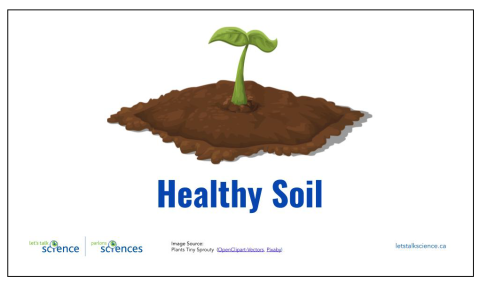
Image - Text VersionShown is a colour illustration of a small green plant growing up from the centre of a patch of brown soil.
They will also look at images and determine whether they think the soil in the image is healthy or not. Finally they will learn what people can do both to harm and protect soil. |
DiscussionsAnimations are provided with each slide so that students can share their ideas before seeing further text. Additional questions and information are also found in the presenter notes. Images and VideosFor students who have visual impairments, use the descriptions provided in the alt text to describe the images. |
Consolidation: 3-2-1 Soils! (20 - 30 min.)
| Instructions | Teaching Tips |
|---|---|
|
Use a 3-2-1 Learning strategy to have students consolidate their learning around the characteristics of soil and soil health. Students could do this on a piece of paper, in a science journal, or on the 3-2-1 Soils! reproducible [Google doc] [Word doc] [PDF] 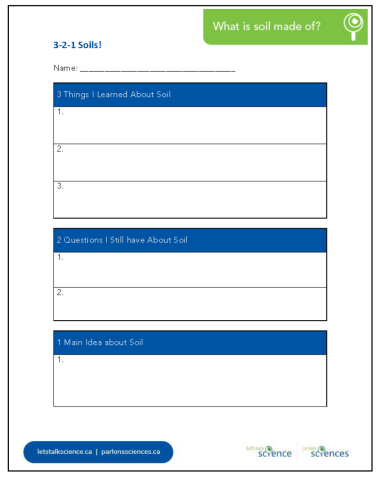
|
LanguageMake sure students have access to a word wall of terminology used in this lesson such as soil, organic matter, nutrient, water, compost, plant, healthy, roots, etc. Incorporate vocabulary in other relevant languages as well (e.g., French). |
Background Information for Teachers
Healthy Soils
Healthy soil is soil that can sustain plants, including crops, horticultural plants and plants in natural ecosystems. In order for plants to grow well, soil needs to hold air, water and nutrients so that they can be easily taken up by plant roots.
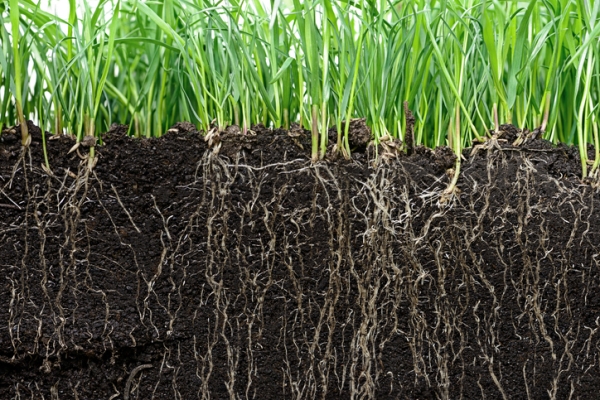
Image - Text Version
Shown is a colour photograph of a cross-section of grass with roots growing down into soil.
A strip of green grass stretches across the top of the photograph. Below, most of the photograph shows its roots in the soil. They are thin, white and squiggly, tangled together like hair. All the roots are growing downward, deeper into the soil.
Soils also provide habitats for many living things, from animals that dig burrows in soil to microscopic creatures such as bacteria. These living things are critical to soil health as they help to break down organic matter into nutrients for plants and open up spaces so that air and water can reach down into soil.
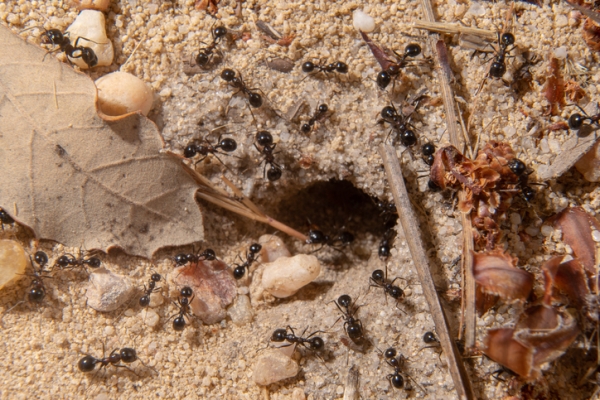
Image - Text Version
Shown is a close-up colour photograph of ants on pale brown soil with a small hole in the centre.
The camera looks straight down on pale, grainy soil that looks like sand. Several dry leaves and twigs lie across the surface. There is a small deep hole in the centre of the image. Black ants crawl over and around the soil and vegetation, and down into the hole.
Additional Resources
Reproducibles
- Healthy Soil [Google slides] [pptx] [PDF]
- 3-2-1 Soils! reproducible [Google doc] [Word doc] [PDF]
Books
The magical world of soil biodiversity
This is a collection of 10 stories for children from around the world on the topic of soil biodiversity assembled by the Food and Agriculture Organization of the United Nations (FAO), the International Union of Soil Sciences (IUSS), and the Global Soil Partnership (GSP) . It can be purchased as a physical book or you can download the book as a pdf.
ISBN 978-92-5-134249-7
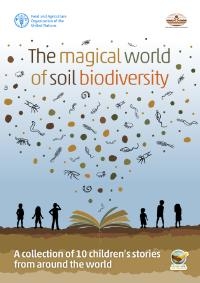
Reproducibles and Media
Reproducibles
- Healthy Soil [Google slides] [pptx] [PDF]
- 3-2-1 Soils! reproducible [Google doc] [Word doc] [PDF]
Books
The magical world of soil biodiversity
This is a collection of 10 stories for children from around the world on the topic of soil biodiversity assembled by the Food and Agriculture Organization of the United Nations (FAO), the International Union of Soil Sciences (IUSS), and the Global Soil Partnership (GSP) . It can be purchased as a physical book or you can download the book as a pdf.
ISBN 978-92-5-134249-7

Science
- Students could create posters advocating ways in which humans can protect soils.
- Go on a field trip to a farm to talk to the farmers about soil quality and see soil close up.
Literacy
- Students could read stories from The magical world of soil biodiversity and use them as inspiration for their own soil stories.
Extensions
Science
- Students could create posters advocating ways in which humans can protect soils.
- Go on a field trip to a farm to talk to the farmers about soil quality and see soil close up.
Literacy
- Students could read stories from The magical world of soil biodiversity and use them as inspiration for their own soil stories.
The Dirt on Soil Conservation
This article, by Let’s Talk Science, explores how humans both can harm and protect soil.
Steeped in Soil
This program from 4H Canada includes an activity book with information and hands-on activities. There is also a Dig into Soil program with an activity book.
Soil Conservation Council of Canada
The SCCC is the face and voice of soil conservation and health in Canada. They have resources and run a National Soil Conservation Week.
Why soil is one of the most amazing things on Earth (2021)
This video (4:29 min.) from the Royal Society explores the importance of soil, and how humans often “treat it like dirt.”
Why Soil Matters (2018)
This video (5:32 min.) from Our Changing Planet makes the connection between soil quality and climate.
Better Save Soil (2015)
This video (3:52 min.) from the Think Tank for Sustainability advocates why we need to protect soils now.
What is soil health?
In this video from the University of Guelph, learn about soil health and how to measure soil health.
Best practices for soil
In this video from the University of Guelph, learn about how people can keep soil healthy.
Learn More
The Dirt on Soil Conservation
This article, by Let’s Talk Science, explores how humans both can harm and protect soil.
Steeped in Soil
This program from 4H Canada includes an activity book with information and hands-on activities. There is also a Dig into Soil program with an activity book.
Soil Conservation Council of Canada
The SCCC is the face and voice of soil conservation and health in Canada. They have resources and run a National Soil Conservation Week.
Why soil is one of the most amazing things on Earth (2021)
This video (4:29 min.) from the Royal Society explores the importance of soil, and how humans often “treat it like dirt.”
Why Soil Matters (2018)
This video (5:32 min.) from Our Changing Planet makes the connection between soil quality and climate.
Better Save Soil (2015)
This video (3:52 min.) from the Think Tank for Sustainability advocates why we need to protect soils now.
What is soil health?
In this video from the University of Guelph, learn about soil health and how to measure soil health.
Best practices for soil
In this video from the University of Guelph, learn about how people can keep soil healthy.
Ontario Ministry of Agriculture, Food, and Rural Affairs (2016). Urban Agriculture Business Information Bundle.
Farm & Food Care (Mar 1, 2021). Soil health in Ontario [Video]. YouTube. https://www.youtube.com/watch?v=kXMPTtZLSnA
Kime, L (Aug 28, 2012). Soil Quality Information. Penn State Extension.
References
Ontario Ministry of Agriculture, Food, and Rural Affairs (2016). Urban Agriculture Business Information Bundle.
Farm & Food Care (Mar 1, 2021). Soil health in Ontario [Video]. YouTube. https://www.youtube.com/watch?v=kXMPTtZLSnA
Kime, L (Aug 28, 2012). Soil Quality Information. Penn State Extension.
Reproducibles
- Healthy Soil [Google slides] [pptx] [PDF]
- 3-2-1 Soils! reproducible [Google doc] [Word doc] [PDF]
Books
The magical world of soil biodiversity
This is a collection of 10 stories for children from around the world on the topic of soil biodiversity assembled by the Food and Agriculture Organization of the United Nations (FAO), the International Union of Soil Sciences (IUSS), and the Global Soil Partnership (GSP) . It can be purchased as a physical book or you can download the book as a pdf.
ISBN 978-92-5-134249-7

Reproducibles and Media
Reproducibles
- Healthy Soil [Google slides] [pptx] [PDF]
- 3-2-1 Soils! reproducible [Google doc] [Word doc] [PDF]
Books
The magical world of soil biodiversity
This is a collection of 10 stories for children from around the world on the topic of soil biodiversity assembled by the Food and Agriculture Organization of the United Nations (FAO), the International Union of Soil Sciences (IUSS), and the Global Soil Partnership (GSP) . It can be purchased as a physical book or you can download the book as a pdf.
ISBN 978-92-5-134249-7

Science
- Students could create posters advocating ways in which humans can protect soils.
- Go on a field trip to a farm to talk to the farmers about soil quality and see soil close up.
Literacy
- Students could read stories from The magical world of soil biodiversity and use them as inspiration for their own soil stories.
Extensions
Science
- Students could create posters advocating ways in which humans can protect soils.
- Go on a field trip to a farm to talk to the farmers about soil quality and see soil close up.
Literacy
- Students could read stories from The magical world of soil biodiversity and use them as inspiration for their own soil stories.
The Dirt on Soil Conservation
This article, by Let’s Talk Science, explores how humans both can harm and protect soil.
Steeped in Soil
This program from 4H Canada includes an activity book with information and hands-on activities. There is also a Dig into Soil program with an activity book.
Soil Conservation Council of Canada
The SCCC is the face and voice of soil conservation and health in Canada. They have resources and run a National Soil Conservation Week.
Why soil is one of the most amazing things on Earth (2021)
This video (4:29 min.) from the Royal Society explores the importance of soil, and how humans often “treat it like dirt.”
Why Soil Matters (2018)
This video (5:32 min.) from Our Changing Planet makes the connection between soil quality and climate.
Better Save Soil (2015)
This video (3:52 min.) from the Think Tank for Sustainability advocates why we need to protect soils now.
What is soil health?
In this video from the University of Guelph, learn about soil health and how to measure soil health.
Best practices for soil
In this video from the University of Guelph, learn about how people can keep soil healthy.
Learn More
The Dirt on Soil Conservation
This article, by Let’s Talk Science, explores how humans both can harm and protect soil.
Steeped in Soil
This program from 4H Canada includes an activity book with information and hands-on activities. There is also a Dig into Soil program with an activity book.
Soil Conservation Council of Canada
The SCCC is the face and voice of soil conservation and health in Canada. They have resources and run a National Soil Conservation Week.
Why soil is one of the most amazing things on Earth (2021)
This video (4:29 min.) from the Royal Society explores the importance of soil, and how humans often “treat it like dirt.”
Why Soil Matters (2018)
This video (5:32 min.) from Our Changing Planet makes the connection between soil quality and climate.
Better Save Soil (2015)
This video (3:52 min.) from the Think Tank for Sustainability advocates why we need to protect soils now.
What is soil health?
In this video from the University of Guelph, learn about soil health and how to measure soil health.
Best practices for soil
In this video from the University of Guelph, learn about how people can keep soil healthy.
Ontario Ministry of Agriculture, Food, and Rural Affairs (2016). Urban Agriculture Business Information Bundle.
Farm & Food Care (Mar 1, 2021). Soil health in Ontario [Video]. YouTube. https://www.youtube.com/watch?v=kXMPTtZLSnA
Kime, L (Aug 28, 2012). Soil Quality Information. Penn State Extension.
References
Ontario Ministry of Agriculture, Food, and Rural Affairs (2016). Urban Agriculture Business Information Bundle.
Farm & Food Care (Mar 1, 2021). Soil health in Ontario [Video]. YouTube. https://www.youtube.com/watch?v=kXMPTtZLSnA
Kime, L (Aug 28, 2012). Soil Quality Information. Penn State Extension.